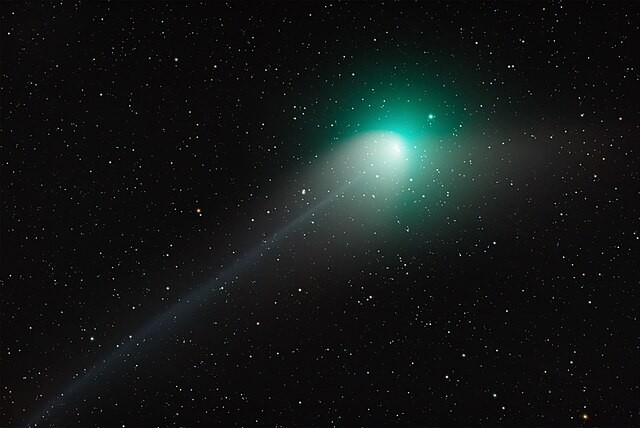
(Photo: Wikimedia Commons/Edu INAF, photographer: Alessandro Bianconi)
The devil comet or horned comet could make a rare appearance during the anticipated total solar eclipse next month. And prior to that, it could show off its streaks across the sky.
Devil Comet To Make Rare Appearance During The Total Solar Eclipse
The devil comet, officially called 12P/Pons-Brooks, will treat the skygazers this month by showing off its streaks across the night sky.
One can see this celestial nomad with a decent pair of binoculars or a telescope. Nevertheless, by the end of March, its brightness will reportedly increase to fifth magnitude, making it bright enough to be seen with the naked eye.
On April 8, 12P/Pons-Brooks might even show up during the total solar eclipse. During the day, 12P/Pons-Brooks would normally be much too faint to view, but if the eclipse makes the Sun darker, there is a chance the comet will emerge from the darkness.
If it occurs, it will appear roughly the width of two fists held at arm's length or about 25 degrees away from the Sun. The exact location on the clock face in relation to the Sun will primarily rely on your point of view when viewing it from Earth.
At most, the comet will resemble a tiny speck in the sky. The total eclipse will be sublime; it will peak in southwest Texas and endure no longer than four and a half minutes or less from certain other spots along its path.
After that, on April 21, it will vanish into the dusk light of April and arrive at the perihelion, or the point closest to the Sun. People in the Southern Hemisphere will be able to see it as it starts to wane.
The 2024 Total Solar Eclipse Is the Best in Centuries
The upcoming solar eclipse will be the best in centuries for several reasons. First, it's the longest since 1806. The total eclipse could last for 4 minutes and 28 seconds in Mexico.
The last totality of this length occurred in North America on June 16, 1806, when a total solar eclipse lasted 4 minutes and 55 seconds and passed over Boston, Baja California, Kansas City, and Albuquerque on its route to Cape Cod.
Also, it will be a solar maximum. The Sun's corona will look wider and more symmetrical during solar maximum, more like a sunflower than a thorny patch. Because of the Sun's magnetic activity, it is anticipated that the Sun will reach solar maximum later this year.
The upcoming eclipse will also be the darkest in 217 years. The level of darkness depends on the solar eclipse's magnitude. On April 8, when the magnitude is 1.05, and the line of totality is around 115 miles wide, Jupiter and Venus will be visible.
Several cities will witness the total solar eclipse. Among the important cities along the route of totality are Mazatlán and Torreón in Mexico; Dallas-Forth Worth-Arlington, Austin, and (portions of) San Antonio in Texas; Little Rock, Indianapolis, Cleveland, Buffalo, Rochester, and Hamilton; and Niagara, St. Catharines, Kingston, and Montreal in Canada. This means that approximately 10 million people will have the opportunity to see the anticipated total solar eclipse.
RELATED ARTICLE: Is the ISS Retiring? NASA Details Plans for Using Privately Developed Space Stations in the Future
Check out more news and information on Total Solar Eclipse in Science Times.



![Earth's Quasi-Moon Kamo‘oalewa Could Originate From Lunar Surface Not Asteroid Belt [Study]](https://1721181113.rsc.cdn77.org/data/thumbs/full/53275/89/56/50/40/earths-quasi-moon-kamo-oalewa-could-originate-from-lunar-surface-not-asteroid-belt-study.png)










